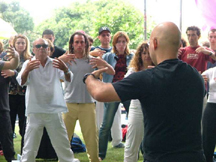Zhanzhuang
| Zhan zhuang | |||||||

Zhan zhuang training on the
World Tai Chi and Qigong Day, Israel. The people in the picture hold the Hun Yuan posture, also known as Cheng Bao. |
|||||||
| Chinese | |||||||
|---|---|---|---|---|---|---|---|
|
|||||||
| Transcriptions | |
|---|---|
| Standard Mandarin | |
| Hanyu Pinyin | Zhàn Zhuāng |
Zhàn zhuāng, literally: "standing like a post", is a training method often practiced by students of neijia (internal kung fu), such as Yiquan, Xing Yi Quan, Bagua Zhang and Taiji Quan. Zhan Zhuang is sometimes translated Standing-on-stake, Standing Qigong, Standing Like a Tree, Post-standing, Pile-standing, or Pylon Standing. It is commonly called a form of Qigong, despite the differences from other Qigong methods in Zhan zhuang's orientation.
The original Zhan zhuang were health methods used by Daoists; in recent centuries, martial artists who already had static standing methods combined these with the internal mechanics of Zhan zhuang to create a superior exercise. The goal of Zhan zhuang in martial arts has always been to develop a martially capable body structure, but nowadays most practitioners have again returned to a health-preservation orientation in their training, and few teach Zhan Zhuang as a martial method.
The word Zhan zhuang is the modern term; it was coined by Wang Xiangzhai. Wang, a student of Xing Yi Quan, created a method of Kung Fu-based entirely upon Zhan zhuang, known as Yiquan, "Intent Fist." Yiquan's method of study is Zhan zhuang plus movements that continue the feeling of the Standing Post in action.
The most common Zhan zhuang method is known as Hún Yuán (浑圆, "Completely Round," "Round Smoothness") or Chēng Bào (撑抱, "Tree Hugging" stance). This posture is entirely Daoist in its origins, has many variations, and is the main training posture in all branches of Yiquan. This practice has recently also become common practice in Taiji and Qigong schools. In Xing Yi Quan, the practice of Sān Tǐ Shì (三體勢 / 三体势, Heaven, Earth, and Man) has been a root practice for centuries.
Those unfamiliar with Zhan zhuang can experience severe muscle fatigue and subsequent trembling at first. Later, once sufficient stamina and strength have been developed, the practitioner can use Zhan zhuang to work on developing the sensation of "opposing forces," as well as one's central equilibrium and sensitivity to specific areas of tension in the body.
...
Wikipedia
